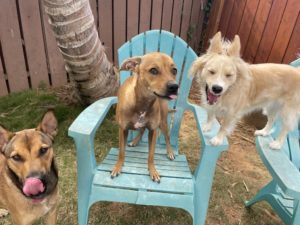Do you understand what your dog is telling you through their body language? I feel it is a great disservice to our dogs if we only expect them to learn what we want through training, but not look deeper at what our dogs need through their body language.

Keep in mind, behaviorally, anything our dog does is information to us. For example, if your dog barks and lunges on their leash, they may be telling you they are scared of something in the environment or frustrated they cannot be free to say hi to another dog friend that they see. To understand if your dog is scared or frustrated in this situation, you can look at their body language.
When I teach classes, I train students to recognize stress in their dogs. If your dog is stressed, it’s very hard for them to learn in that state of mind. If a dog is stressed in class, I put more space in between the dog and its stressor (normally the other dogs). I ask the owner to focus on the dog being comfortable instead of working on the particular exercise we are doing in class. The owner can go home and focus on training in an area that isn’t causing their dog stress. Sometimes class isn’t the best learning situation for a dog. Instead, private lessons in the comforts of their own home are better.
Here are some signs your dog is stressed:
- Ears back, whale eye, tail tucked, furrowed brow
- Panting, lip licking
- Avoiding your requests
- Scratching
- Pacing
- Whining
- Shedding or blowing their coat
- Yawning
- Fleeing – trying to escape the situation
- Not eating
Some overlooked times your dog might be stressed are:
- When you’re trying to take a picture of them, they either lip lick, yawn or constantly turn away from the camera as in the picture above.
- When you’re asking your dog to do a behavior, but they scratch themselves instead.
- When they refuse one of their favorite treats.
WHAT TO DO IF YOUR DOG IS STRESSED
First and foremost, recognize signs of stress and do not continue to push your dog through it. Here are additional tips:
- Put more space in between your dog and what they are stressed about
- Pick up your pace to fast walk or light jog to help redirect your dog’s attention, but also to get out of the situation. Do not pick up your pace in an anxious manner such as ‘oh my gosh I gotta get us outta here’ while tugging tightly on their leash. Instead, think to yourself in a happy tone of voice ‘let’s go, over this way’, while keeping the leash loose.
- Train ‘look’ or ‘touch’. Giving your dog something else to do can help redirect your dog’s attention.
- If there is a house you walk by with dogs that bark through the fence and stress your dog, either walk across the street before getting there or take another route. See steps below to desensitize them to that house.
If you recognize your dog is stressed in a situation, you can work with this by keeping a distance from the area or thing they are stressed about. For example, if they are stressed when they see kids on skateboards 10 feet away, move 20 feet away from the kids on skateboards. Positively associate what your dog is stressed about by keeping a distance and playing (fetch or tug) or running back and forth. Or you could just sit, watch, and pass out treats at a distance where your dog is not stressed. Keep the time that you are around your dog’s stressor short and fun. This might only be 30 seconds, or last 5 minutes or more. I cannot stress enough to keep your sessions short and fun! Slowly work your way closer to that which your dog is stressed about. Keep it fun for your dog so they will want more the next time you go back.
It is hard to say how long it will take your dog to be comfortable with that which stresses them. Here are some variables:
- It depends on the previous history of the situation: was it really scary or awful for your dog or just a little startle?
- Have you tried to positively associate your dog to what they are stressed about?
- Do you end your training sessions on a positive? Ending when they are not understanding something and stressed can make for a stressful training session next time.
- Do you have realistic expectations for your dog?


For a light hearted look at canine body language, take a look at Doggie Language!






